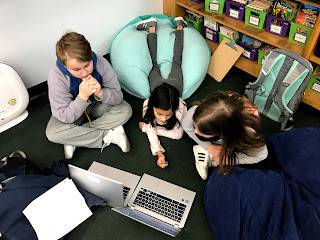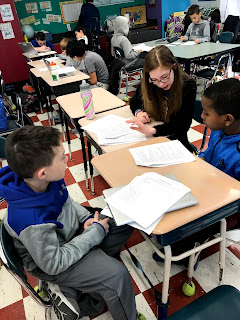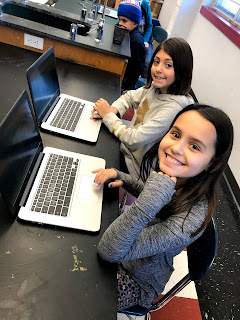 In ELA this week, we had one focus: main idea. We spend a large portion of our nonfiction unit on strategies to find the main idea and supporting details of a nonfiction text. For example, students are encouraged to preview the text and find the topic first. This is the subject, and it is generally stated in one or two words. The main idea is the most important point that the author is trying to make about the topic. This is a complete sentence that should include the topic. So a text's main idea might be, "Technology has changed over time.", "Turtles and tortoises are different species of animals, yet they have many similarities.", or "The John F. Kennedy School is a K-8 elementary school in Somerville." Supporting details are facts from the text that give more information about the main idea. Consolidating all of the information in a text and picking out the most important idea, along with key details to support it, requires a lot of higher level thinking skills, especially as the texts get harder. So I called in some reinforcements. Ms. Ward is our school's 6th grade ELA/SS teacher. She is absolutely awesome, and it's been great bouncing ideas off of each other related to curriculum, instruction, texts-- everything really! We met last week and I voiced how challenging this unit can be, for both the students and for me. So we came up with a plan for the week before break. Her 6th graders would select an online article on a topic that interests them, and create a mini lesson around finding the main idea and supporting details of their chosen text. Then we'd pair each of them up with a 4th grader to teach their lesson. Well, this activity exceeded my expectations. Ms. Ward's students only had two days to prepare, but many of them came to my room on Wednesday with learning targets, worksheets, even slide shows. It was sooo cool to see the kids learning from each other. Both grade levels reflected on how things went afterwards, and the consensus of both groups? We absolutely need to do something like this again.
In ELA this week, we had one focus: main idea. We spend a large portion of our nonfiction unit on strategies to find the main idea and supporting details of a nonfiction text. For example, students are encouraged to preview the text and find the topic first. This is the subject, and it is generally stated in one or two words. The main idea is the most important point that the author is trying to make about the topic. This is a complete sentence that should include the topic. So a text's main idea might be, "Technology has changed over time.", "Turtles and tortoises are different species of animals, yet they have many similarities.", or "The John F. Kennedy School is a K-8 elementary school in Somerville." Supporting details are facts from the text that give more information about the main idea. Consolidating all of the information in a text and picking out the most important idea, along with key details to support it, requires a lot of higher level thinking skills, especially as the texts get harder. So I called in some reinforcements. Ms. Ward is our school's 6th grade ELA/SS teacher. She is absolutely awesome, and it's been great bouncing ideas off of each other related to curriculum, instruction, texts-- everything really! We met last week and I voiced how challenging this unit can be, for both the students and for me. So we came up with a plan for the week before break. Her 6th graders would select an online article on a topic that interests them, and create a mini lesson around finding the main idea and supporting details of their chosen text. Then we'd pair each of them up with a 4th grader to teach their lesson. Well, this activity exceeded my expectations. Ms. Ward's students only had two days to prepare, but many of them came to my room on Wednesday with learning targets, worksheets, even slide shows. It was sooo cool to see the kids learning from each other. Both grade levels reflected on how things went afterwards, and the consensus of both groups? We absolutely need to do something like this again.
With the craziness of our party, picking our weekly Bucket Fillers got lost in the shuffle. So we'll have lots of names to pick from on the week we get back. We hope the kids like the personalized pencils and sharpeners given to them at the end of the party. (Let's just say that, in reality, these serve as a bit of a present for us teachers too...) Thanks so much to all those who gave me such generous and thoughtful gifts! Happy holidays to everyone, and see you in 2019. (< Sorry...I had to.)



















































